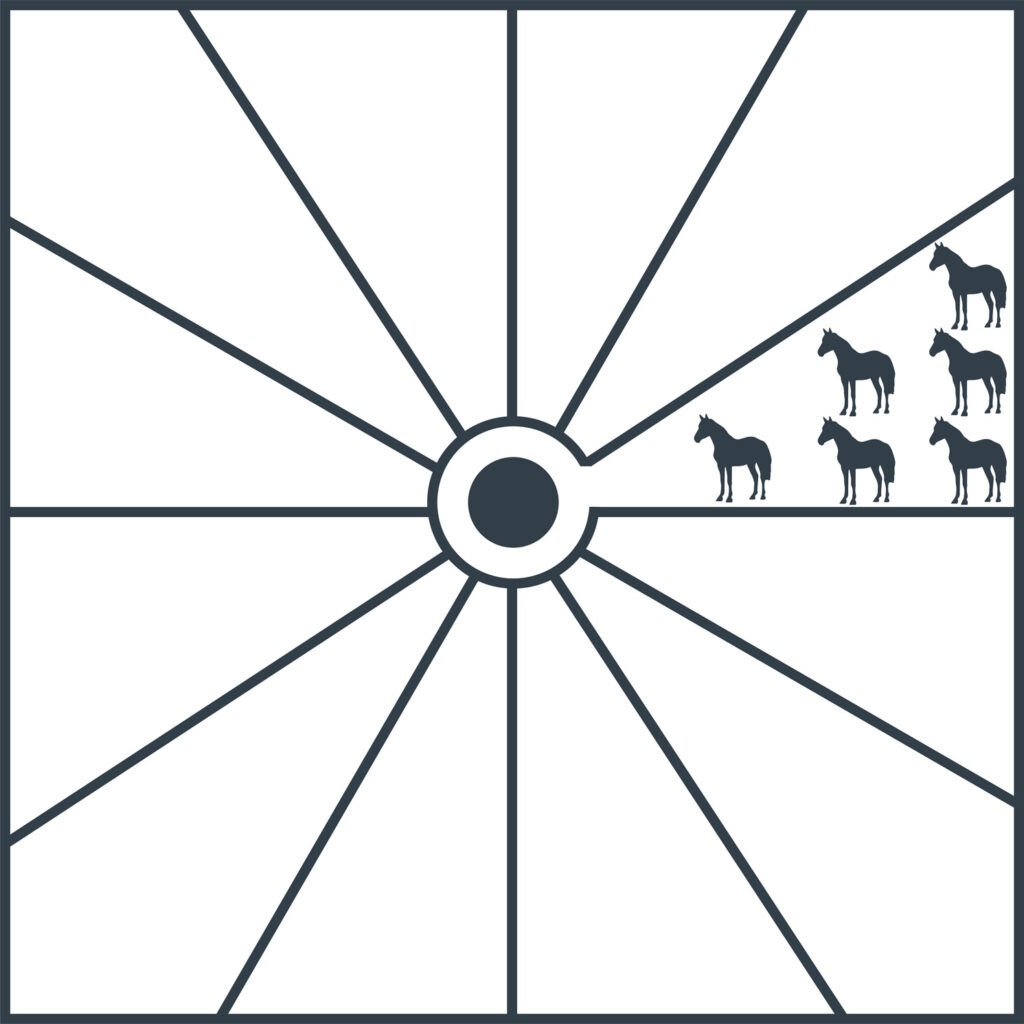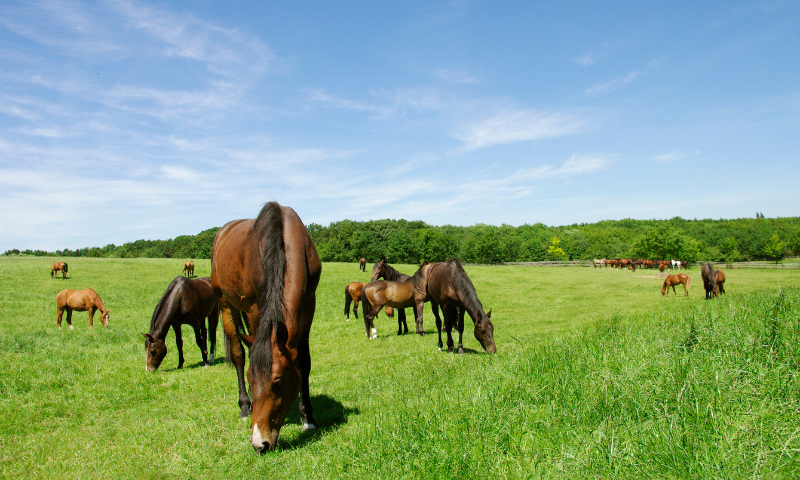Having a horse paddock filled with abundant grass species and beautiful fencing is the dream for many horse owners but can be significantly challenging to achieve. Well managed, high-quality pastures can meet many nutrient requirements of horses and can significantly reduce the cost of supplementary feed, especially hay. Unfortunately, many horse pastures are often dominated by weeds due to overstocking and selective grazing of palatable plants species.
Tips for establishing a high-quality pasture
To establish and maintain healthy, productive horse pastures there are a few important factors to consider:
Soil Test
Improving soil health should be a priority because it is a prerequisite for healthy plant growth as plants require a solid foundation with an adequate balance of nutrients to grow. Furthermore, horses are herbivores, and they require plants with an appropriate balance of nutrients to graze for them to be able to maintain health and performance.
Soil testing with a complete mineral analysis is a relatively cost-effective way to assess nutrient availability in the soil and whether any issues need to be addressed through pasture management or fertiliser application. One or more soil tests may be necessary, depending on the size of the property, variation in soil types and the paddock history.
Fertiliser
NatraMin mineral fertilisers and soil conditioners are designed to assist soil regeneration by addressing the nutritional, biological and structural aspects of soil fertility. Apply the recommended NatraMin blend (as per soil test) once or twice a year by spreading over existing pasture or applying directly to the soil around 6 weeks prior to planting. When planting a new pasture, a starter fertiliser as recommended by your local rural store or agronomist will also assist the establishment of new plants.
A major advantage of using NatraMin for horse pastures is that these products are made from natural rock minerals that have no withholding period so paddocks can be grazed immediately after spreading. NatraMin may replace the need for lime and gypsum, with NatraMin providing additional benefits by providing a broad range of macro and trace minerals, stimulating microbe and worm activity that help to convert mulch into humus, creating more friable soil.
Weed Control
Weeds can be a major problem when trying to establish new pastures as they compete with sown pastures for nutrients, moisture, and sunlight. It is important to identify existing weeds and how best to manage them. If a new pasture is to be planted aim to spray weeds out prior to sowing to reduce competition for new seedlings.
An ongoing weed management plan should be included as part of your pasture management, and they can be controlled using chemicals, physical weed control methods (pulling, cutting, or digging out of weeds) or by using fire.
Paddock Management
Since establishing a new productive pasture can be costly as well as time-consuming, it is best to do one to two paddocks at a time, rotating around them, and do a certain area each year if needed.
It is highly recommended to split paddocks up into smaller areas as this allows rest and recovery time for pasture and supports the regeneration of palatable species. Rotational grazing or strip grazing (with back fencing) is ideal for horses and can provide a way to budget available pastures.
When establishing paddocks for rotational grazing watering points can be an obstacle especially if permanent watering points such as dams and creeks are in use, however, with careful trough set up, they can be designed to service more than one paddock as per the below diagrams.
Consider dividing flat ground and slopes into separate paddocks to enable flat areas to be rested by keeping horses off them during wet periods.


Selecting A Pasture Mix
Planting as large a variety of plant species as possible is advisable as it offers a larger nutrient variety to horses and is better for soil health. Discuss with your local rural store or agronomist regarding what pasture plants will grow in your area (particularly regarding climatic and pasture drainage conditions) and aim to select a few grass species in conjunction with some deep-rooted legumes and herbs. Avoid mixes that include grasses that contain high levels of oxalate (setaria, kikuyu, buffel, green panic, purple pigeon, signal, para, and guinea grass) as this will interfere with calcium absorption by the horse.
Here are a few plant species that are suitable for horses:
- Rhodes grass
- Bluegrasses (Queensland, Creeping and Floren)
- Digit grass
- Annual medics
- Lucerne
- Cocksfoot or Orchard grass
- Crested Dog’s Tail
- Burgundy bean
- Prairie grass or Brome grass
- Brown top
- Timothy
Use with caution:
- Clovers (use low oestrogen varieties and horses generally don’t find white clover palatable) help fix nitrogen into the soil.
- Ryegrass (use low endophyte varieties and not suitable for horses requiring a low non-structural carbohydrate diet)
- Fescue (only use endophyte-free varieties)
A useful read is Plants Poisonous to Horses An Australian Field Guide by Mellisa Offord (2022) and is a free download published by RIRDC.
Planting and Management of Newly Planted Pasture
Apply the appropriate NatraMin Blend 4-6 weeks prior to planting new pasture seed. Some mixes can be sown over the existing pasture, but this is more suitable for legumes and herbs as most grass species require seed to soil contact for successful establishment. Cultivation may be required to create a seedbed; it is also a good idea to roll the paddock once the seed is sown to help with seed to soil contact. Ensure that adequate seeding rates have been used alongside a starter fertiliser to maximise early growth, helping to provide ground cover which will assist in suppressing weeds. Contractors can be hired if you don’t have the necessary equipment and a good place to go for advice or referrals is your local rural store.
It is imperative that the newly seeded pasture is protected until the new plants are well established. It might be necessary to nurse the new pasture for the first 6-12 months to ensure long term persistence and production. Be patient as new pastures shouldn’t be grazed too soon. To test whether plants are ready for grazing try pulling them and if the roots come out, they aren’t ready, if the plants remain intact then they are good to go. It is important to only graze new pastures for a short period and then give them a rest and recovery phase. It may be preferable to mulch or slash instead of grazing first to encourage plants to establish a quality root system and tiller out for maximum ground cover.
Do not overgraze or overstock the paddock as overgrazing pasture to the ground (mostly due to small acreage and too many horses) creates several issues and is a major contributor to the increase of weeds and decrease of palatable pasture species.
Supplement
It doesn’t matter how good your horse pastures are, they still won’t be able to supply all your horse’s nutritional requirements especially for trace minerals. Therefore, it’s recommended to provide grazing horses with a good quality mineral supplement like MegaMin Equine Enhancer to help meet shortfalls in essential nutrients.
For further information on NatraMin Mineral Fertilisers and Soil Conditioners or MegaMin Equine Supplements contact AgSolutions on 1800 81 57 57.
